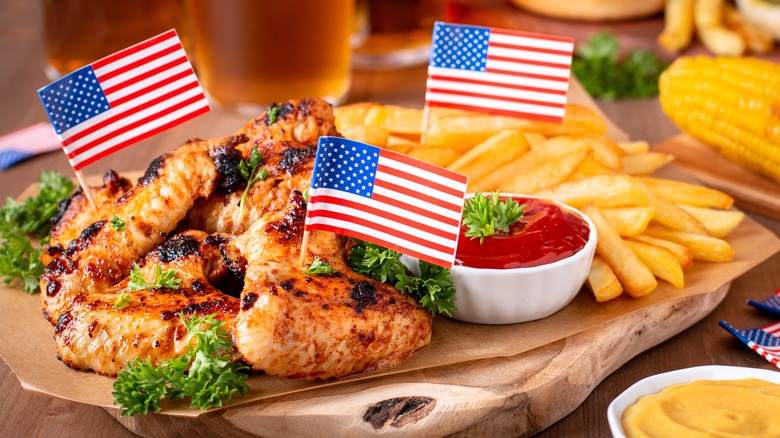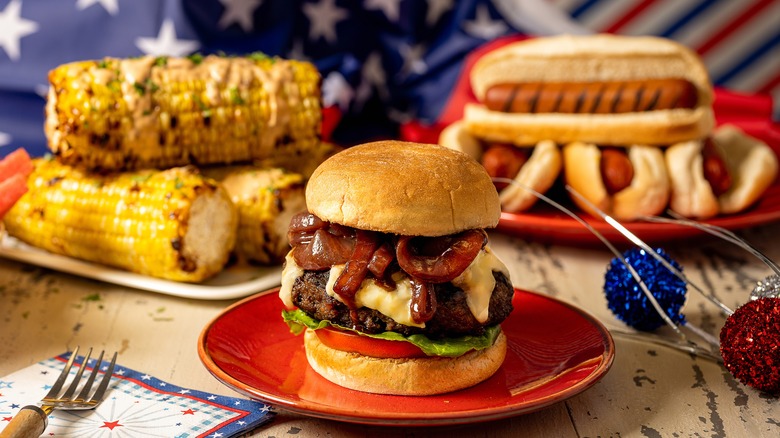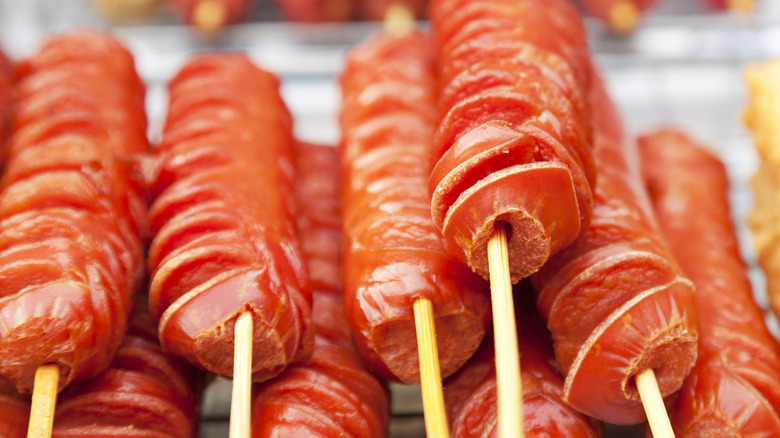Why Barbecue Is Traditionally Eaten On Fourth Of July
When the Founding Fathers penned the Declaration of Independence, they might as well have included a line about the self-evident truth that most Americans would celebrate the Fourth of July with barbecue. In 1776, John Adams even predicted that Independence Day would be celebrated for generations with fireworks, parades, and food. And, although there is less cannon fire nowadays, many of these traditions have stuck, including barbecue, which can be traced back to the early 1800s.
At this time, the patriotic holiday was initially commemorated with political rallies. To entice people to attend, party leaders held city-wide barbecues in the town centers and created unity over the shared meal. For the new Americans colonists, who hailed from Europe initially, barbecue was a new cooking technique adopted from the West Indian island of Hispaniola. It's derived from the Spanish word "barbacoa," a meat dish now associated with Mexican cuisine, as in enchiladas rojas with barbacoa.
Since the entire community came out for the free meal, whole oxen or hogs were barbecued in order to feed the crowd. Today, Americans continue to enjoy a similar carnivorous feast of beef and pork with European-named foods like hamburgers and frankfurters.
How have Fourth of July celebrations changed?
The first Fourth of July celebration, complete with fireworks, took place in 1777 in Philadelphia, Pennsylvania. Following the War of 1812, annual celebrations spread throughout the nation to include more rural communities for the first time. By 1870, Congress declared July 4th a federal holiday, ensuring that Americans from coast to coast could celebrate Independence Day.
As the United States population grew during the 20th century, and with the July 4th holiday allowing time off, celebrations started to shift from community-wide barbecues to private backyard cookouts, especially as more Americans adopted home grills.
Today, 70% of American households own a grill, per the Hearth, Patio & Barbecue Association, and according to the organization's recent survey, July 4th is the most popular day of the year to barbecue in the U.S., with 58% of Americans doing so. While a majority still grill steak (a throwback to the early oxen barbecue meat in America's past), our modern diet is really a fusion of flavors from around the world. Along with the usual suspects, it's common to find vegetarian options like veggie skewers and more hints of international influence on the grill.
What do Fourth of July barbecues look like now?
Initially, barbecuing was prominent in the South, while cities like Philadelphia and Boston celebrated Independence Day with turtle soup. Now, the entire nation looks forward to Fourth of July barbecues and having at least one hot dog.
Since it was introduced to the U.S. in the 1860s, most Americans have replaced bowls of hot soup with hot dogs for the holiday. According to the National Hot Dog and Sausage Council, around 150 million hot dogs are consumed on July 4th, also making it the second most popular food to eat at a barbecue (per Statista). In addition, smoked brisket and are popular picks.
Google Trends indicates that Japanese barbecue sauce and Korean-style barbecue searches have risen as much as 2,000% between 2019 and 2024, indicating the rise of these global trends. Unlike traditional American versions, the Asian sauces incorporate ginger, sesame oil, and rice vinegar for a sweet and salty barbecue. To complement the rich meat and combat the historically sweltering temps, tangy cold foods like German potato salad, Italian deviled eggs, and Dutch coleslaw have also become modern-day favorites.



